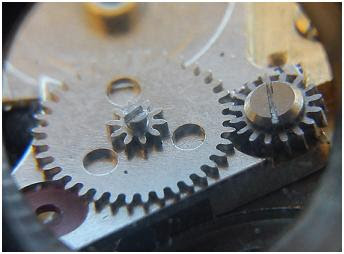8 March 2011
This will (probably) be the last post on the blog.
I have really enjoyed this build, and I'm feeling a little restless now when it is finished, however, I will let the watch run fore a few weeks, then give it a final service, so that eventual unwanted wear can be detected and adjusted.
It all started with an experiment of getting a 6497 to run backwards, my intention at first, was not to go as far as making a complete watch. However, the steps came natural and soon I was on my way...
The project has been about rebuilding an existing movement, with as little manufacturing of new parts as possible, working with what I have. I feel successful with this aspect, the only thing I have had to make is a screw for the minute wheel, all other details are modified original parts from the 6497, the only extra parts I have needed is one setting lever, one sliding pinion and one winding stem, I have also needed three extra screws for the setting mechanism and two new jewels.
The watch is far from perfect, I regard the watch as a kind of prototype, a proof of concept. If I were to do it again I wouldn't change anything, even though there are different ways of solving the problems. Instead of having the setting mechanism on the movement side it can remain on the original dial side. This can be done by drilling a hole through the centre axis and having an extra axis pressed through, acting like an inverted canon pinion, which the minute hand can be mounted on and then having the minute and hour wheel on the movement side. But I liked the challenge of moving the setting mechanism, and I like the look of having it visible on the front side, and two crowns. Not many watches have the setting mechanism visible, almost only skeletonized watches without dials show this mechanism. And I must admit, it is a fascinating piece of mechanics, you pull the crown out, and the sliding pinion moves in on the same axis. For a watchmaker this is absolutely nothing spectacular, but someone who doesn't know so much about watches, really appreciates seeing this happening.
There is also the way of off-centering the dial, then the watch can run in its original direction, but that's cheating... And with that solution the sub second can't be used, the second hand will turn in the wrong direction.

One thing that I am thinking about, is the possibility of extending to a 6497 Flipp Automatic. This is very possible because there is nothing left on the old dial side. By making a new barrel arbor and rebuilding the winding mechanism again, I can take pretty much any automatic bridge and mount it on the old dial side, and adding weight to the rotor. There isn't room right now in the case, however, I am sure I can fit a domed crystal on the back side, to create more space. Maybe it won't be the most comfortable timepiece on the wrist, but extremely unique.
If I were to do this, I will continue on the blog, but not in the near future.
I was planning on having the back side engraved, but I will have to wait until I decide if I am going to continue with the automatic.

Works with a 24mm NATO-strap too.
I would like to thank all readers for your time, hope you have enjoyed following the project, I certainly have!
Regards
Matthias


















































